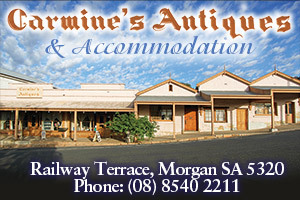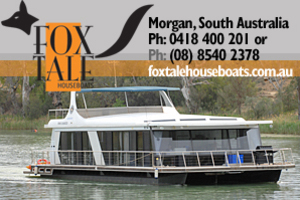
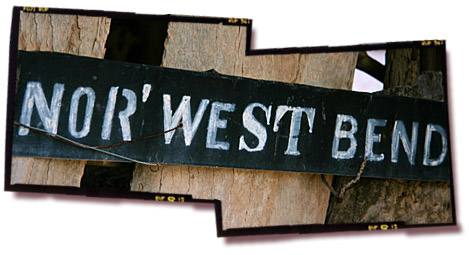 History of the Morgan Township
History of the Morgan Township
Early Pastoral Activity near Morgan
As early as 1851 (and possibly earlier in the form of occupation licenses) land in the Morgan area was held under pastoral leasehold. The first attempts at sheep farming at the Nor’ West Bend Station were unsuccessful mainly due to heavy losses of stock from starvation, ravages of wild dogs and poisonous weeds. Subsequently most of the frontages to the river were sold or parcelled off for commonage, with the result that it was difficult to then water stock on the North West Bend run.
Leases on land covered approximately 100 square miles, and included land which was later designated as special survey blocks, and which extended along the western bank of the river from Morgan to where Brenda Park (now Penfold’s Herbert Leslie Estate) now stands.
It is interesting to note that the Brenda Park Station was leased to Hermann von Reiben in 1856, and behind the old homestead there is a private, fenced-in cemetery containing the graves of several of the von Reiben family.
The following descriptive account has been taken from the South Australian Gazetteer published in 1866:
‘North-West Bend, or Von Reiben’s, 34° S.lat., 139° 40’E. long. (Co. Eyre,) is the name of a post office at the North-West bend hotel, c- the main road from Adelaide to Wentworth, and on the river Murray, the hotel being situated on a lagoon lying parallel with the river, and half a mile distant to the W. of it. This lagoon is deep and contains permanent water; it abounds in fish, and is the breeding-place of immense flocks of aquatic birds. It lies in the hundred of Eba, the district being a pastoral one, stocked with sheep and cattle. The nearest townships are Blanchetown, 23 miles S.; and Kapunda, 45 miles W. by direct road; the communication with the former place being by Rounsevell’s weekly mail coach, and with the latter by horse or private conveyance. With Adelaide the communication is by Rounsevell’s weekly mail coach via Blanchetown to Freeling, and thence by rail, the distance by that route being 117 miles; or by horse or dray to Kapunda, and thence by rail, 92 miles. There is also communication by the river steamers to Goolwa, and thence by coasting steamer. The North-West Bend hotel (von Reiben’s) is a calling place for Rounsevell’s line of intercolonial coaches, the next hotel being Mallyon’s, 16 miles N. E., and also on the main road to Wentworth. The surrounding country consists of an extensive plain, which lies about 100 feet above the level of the river; it extends about 40 miles E. and W., and is sandy and intersected by dense belts of mallee scrub. The predominating formation is tertiary, represented by limestone very rich in tertiary fossils.’
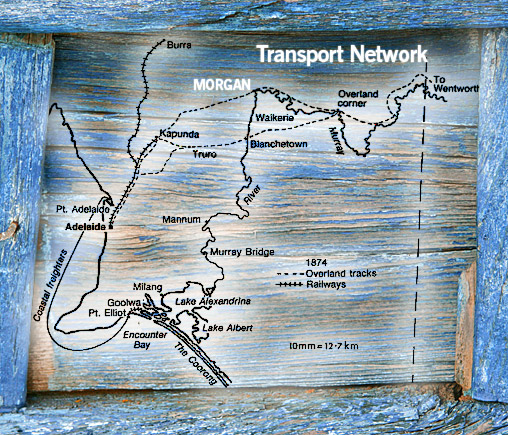 The description undoubted refers to the old Brenda Park Station, where the crumbling remains of the old hotel, coach and horse stables and the original homestead are still to be seen.
The description undoubted refers to the old Brenda Park Station, where the crumbling remains of the old hotel, coach and horse stables and the original homestead are still to be seen.
The township of Morgan was so named by Governor Musgrave in honour of Sir William Morgan M.L.C., who was at that time Chief Secretary of State, and later twice Governor of S.A. The history of Morgan is a vital and integral part of the history of the Murray. However, when we somewhat loosely talk about the history of the Murray, we are not really referring to some 1,400 miles of waterway which has flowed, with only minimal variations at the hand of man, for millions of years in the same old manner. History, in essence, is really an account in chronological order of man’s accumulation of knowledge, and of how he has been able to supply that knowledge to bring about changes in his environment in a search for a better way of life.
The invention of steam, for instance, meant the demise of wind-driven sail vessels. Further specialized use of the same power in locomotives later brought about the collapse of the paddle steamer trade, and now the internal combustion machine in the form of road transport has torn up the railway tracks.
History could in one way be described as a study of the casualties in the relentless advance of science and technology-the rotting hull of the old barge slowly sinking further each year into the mud bank, the once proud old paddle steamer `Gem’ now so ignominiously forced to serve as a floating restaurant, the old rusting away, discarded farm implements and horse drawn vehicles, and nearer to home, Morgan’s deserted, dilapidated, crumbling old shops and houses, all sad and sorry testimony of the inexorable and often ruthless evolution of man.
Morgan is a Government-surveyed town. Charles W. Smith, who surveyed the town in 1878, in a memorandum to The Surveyor General written from ‘North West Bend’ stated that the blacks called the site of this town `KOERABKO’ which they said meant a great place for honey and meetings of the tribes. We remembered seeing this word ‘KOERABKO’ above the door leading into the lounge of the Commercial Hotel, so one afternoon, after football, we decided to go in and investigate. It was certainly a great meeting place of the tribes, but we were somewhat puzzled by the foaming white tops on the honey pots.
At the time of the survey there appears to have already been some settlement at what was then known as ‘North West Bend’, as Surveyor Smith on his diagram of survey shows a Graves Reserve and some buildings, including an hotel on the bank of the river on what is now the Ferry and Water Reserve adjoining the Railway Reserve. The new town was laid out in 213 allotments containing generally 1/4 acre. These allotments were offered at auction on 16th May, 1878, and 27th June, 1878.
Morgan was essentially a Government town, and was meant to be just one of a group of Government-surveyed townships in the area-the others being Chowilla (behind Morgan) and North West Bend over the other side of the river. Morgan went ahead, and the others did not. We could go even further and say that Morgan was a `political’ town -a product of early intercolonial jealousies. The S.A. Government of the day was most anxious to secure from Victoria and N.S.W. a much bigger slice of the river trade, and linkage of the river to the capital by railway was obviously the answer. N.S.W. already had its rail linkage with the Darling River at Bourke, and Victoria with the Murray at Echuca, but S.A. had one big advantage over the other states, and she was not using it to the full its capital, Adelaide, was much nearer to the mouth of the Murray the end where the water was deepest, and lasted longer. At times when the ‘top end’ had run dry the ‘bottom end’ in S.A. could still enjoy much longer periods of navigable water.
This meant the boats could still, with skillful manoeuvering, go long distances up stream, particularly on the Darling in search of cargoes, and return in time to reach Goolwa before the ‘bottom fell out’. The extra navigable times, however, were to a large extent being negated by the high cost of taking the goods all the way down to the mouth, there to be off-loaded onto bullock wagons for the slow, long haul to the railhead at Strathalbyn, and then railed to Port Adelaide, or the long way round via Victor Harbor. There had to be a quick, more direct and less costly route, and a railway to Morgan was the simple, but urgent, answer.
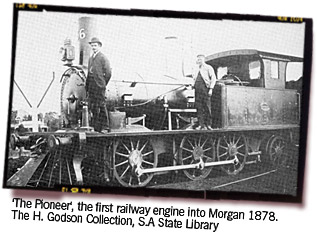 It is not surprising then that the locomotive ‘Pioneer’ made its first trial run to Morgan as early as 17th April, 1878, and that by that time a substantial part of the 30 foot high wharf was already in operation.
It is not surprising then that the locomotive ‘Pioneer’ made its first trial run to Morgan as early as 17th April, 1878, and that by that time a substantial part of the 30 foot high wharf was already in operation.
The S.A. Government wanted action. From then on Morgan was not to be left to grow gradually and haphazardly, as many other country towns had done, and were still doing. It needed a planned and rapid growth, and it surely got that. Within a couple of years goods traffic through Morgan grew to such enormous proportions that six trains a day were coming and going from Adelaide. The five steam-operated hydraulic cranes on the wharf were working 24 hours a day during the high-water season, with gangs of up to 40 men working continuous shifts.
Boats and barges would be lined up for up to a 1/4 mile along the bank, and none would have to wait long before being unloaded, and sent off again in search of more revenue-making cargo.
The venture had succeeded. The river/rail transport system was cheap, quick and reliable, and had opened up new and exciting opportunities for both the river traffic and people on the land. The goods could now begin flowing in both directions-the produce to the outside markets, and heavy capital items could be brought in to open up the country. And surrounding it all was the extreme urgency for getting it all done while the seasonal waters held out. Scores of new and better boats suddenly appeared on the waterways-boats that were faster, boats that drew less water, so they could run the shallows, and ply further up the rivers and estuaries. With the fierce competition that followed, it was inevitable that some would succeed and some would fail.
Those that succeeded went on to become fleet owners, and formed small companies like the Gem Navigation Co., Francis & Tinks, Bailey & Sons and Landseers. Individual competition certainly stimulated growth and development, but it also, in time, lead to losses through unnecessary duplications of manpower, of boats and barges, of wharfage and of warehouses. There was always the urgent need to provide the cheapest possible freight rates if the river transport industry was to survive the challenge of the railways and the looming threat of the developing road transport.
The small river-boat companies could see that they were in danger of destroying each other. There was but one solution amalgamation, and thus was formed Murray Shipping Ltd., the giant that was, with the advent of the locks, to make a last stand and keep the riverboats steaming a little longer, until finally and inevitably, total capitulation. One unique and colourful era had come to a grinding halt. The furnaces went out, the smoke stacks vanished, the paddles stopped churning and the boats and barges drifted to the banks to lay idle. The deck hands walked off, and the river transport finally and irretrievably collapsed.

Morgan’s Riverboats and River Men
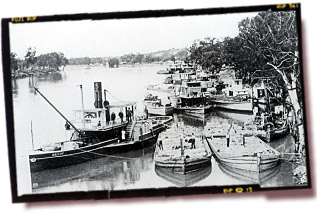 No attempt has been made in this volume to make an in-depth study of the saga of the river boats, as there are already in existence adequate coverage in such works as Ian Mudie’s ‘Riverboats’ and ‘Riverboats and Rivermen’ by W. Drage and M. Page and many others. Instead we have confined our attention to the local area, and our information has come mainly from Morgan’s own fine old river characters. And who more fitting to open the discourse than genial Syd French, whose personal experiences on the river began about 1922, when he started off as a deck hand and later finished up with a mate’s ticket.
No attempt has been made in this volume to make an in-depth study of the saga of the river boats, as there are already in existence adequate coverage in such works as Ian Mudie’s ‘Riverboats’ and ‘Riverboats and Rivermen’ by W. Drage and M. Page and many others. Instead we have confined our attention to the local area, and our information has come mainly from Morgan’s own fine old river characters. And who more fitting to open the discourse than genial Syd French, whose personal experiences on the river began about 1922, when he started off as a deck hand and later finished up with a mate’s ticket.
Syd served on many boats beginning with the ‘Waikerie’ under Captain Tinks, also of Morgan. He quickly graduated to barge master on the ‘Success’. We asked him to give the normal length of a barge towline, and in typical fashion he replied `about as far as you can throw a potato’ and from this we estimated the length to be about 100 ft.
In the twenties many of the S.A. boats such as the ‘Renmark’, `Decoy’ and `J. G. Arnold’ were carting materials for the construction of the locks. The `Decoy’ was also used in 1927 to carry fresh water to Tailem Bend for use by the railways. They sometimes had to go as far up stream as Stonewall (7 miles up from Mannum) to obtain water free from salt, in the days before the barrages became an effective barrier to the invading sea waters.
Syd also had several trips up the Darling even as far as Bourke, and he was there all the time the rivers were in flood in 1931. During that year the barge ‘Ukee’ carried a record 2,250 bales of wool in one load. In addition to bringing out wool that year they also distributed large quantities of general merchandise to about 70 odd st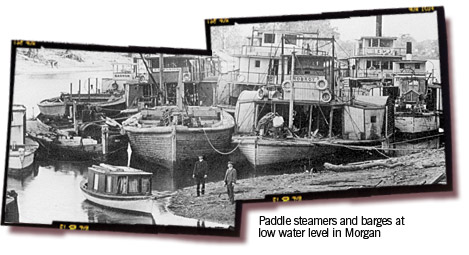 ations, homesteads, wool sheds, hotels and other stopping places in the 300 miles from Wentworth to Menindee.
ations, homesteads, wool sheds, hotels and other stopping places in the 300 miles from Wentworth to Menindee.
With another of Captain Tinks boats, the ‘Cannally’ they carried 400 cases of beer from Morgan and timber for the construction of the Berri distillery in 1923. On the return trips they brought back dried and fresh fruits for the Adelaide market. In the season 1926 the ‘Renmark’ and `William Davis’ operated almost exclusively in the Darling, collecting wool and delivering it to the larger pick-up boats and barges at the junction with the Murray.
Syd tells a humorous tale about the time they were trying to drive four pigs down the gangplank to the bank. They had no trouble with the first three, but the fourth one refused to budge, and sat down firmly and stubbornly on the plank. The owner, however, soon solved the problem by kicking the pig over the side into the water, where it then swam to shore and into the owners waiting hands. Syd thinks that was probably the pig’s first (and certainly its last) bath day.
Another unusual incident happened at Morgan when a long line of boats were tied up end-toend along ‘Rotten Row’. A strong wind sprang up, and broke the down-end rope, although the top mooring still held good. As a consequence the whole line of boats were blown upstream like the tail of a kite. Ron Johnson then took the ‘Renmark’ and rounded up the runaways, and pushed them back into line along the bank.
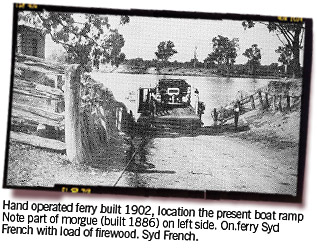 During the slack low river periods and after he finally left the river in 1945, Syd delivered wood in his truck to his brother’s saw mill in the Morgan railway yard. The firewood was mostly railed to Adelaide.
During the slack low river periods and after he finally left the river in 1945, Syd delivered wood in his truck to his brother’s saw mill in the Morgan railway yard. The firewood was mostly railed to Adelaide.
Our picture shows Syd’s truck loaded with wood on the old Morgan punt, which then operated from the present boat ramp. Part of the river bank morgue is visible on the left. Long forgotten now are the sad and tragic circumstances surrounding those times when that small, square stone morgue building at the left hand side of the present boat ramp had to become the last port of call for many an ancient river man.
The very first punt in operation at Morgan was hand-driven, and often the truck drivers would help the punt man to wind the punt across the river. During one crossing with cattle the punt tipped up, and jettisoned the stock into the river. One black and white cow later clambering out of the water with a punt gate around its neck. Syd French had filled us in marvelously concerning the post first world war period, so then we looked around for something from the real early times.
We found what we wanted after a trip to Felixstowe in Adelaide for a most interesting and rewarding chat with Mr. E. C. (Jack) Diener. The Dieners were a special breed of rivermen. They ran trading boats, hawking steamers or `rag boats’ as Mr Sam Watson called them.
Excerpts from “Morgan Centenary 1878 – 1978” by J.W.R. White
Printed by Lutheran Publishing House Adelaide SA 77-995
Published by The Morgan Centenary Committee Inc. Morgan South – Australia 1977




